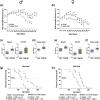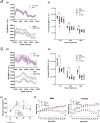Repurposing of Trimetazidine for amyotrophic lateral sclerosis: A study in SOD1G93A mice
- PMID: 34783031
- PMCID: PMC9305494
- DOI: 10.1111/bph.15738
Repurposing of Trimetazidine for amyotrophic lateral sclerosis: A study in SOD1G93A mice
Abstract
Background and purpose: Amyotrophic lateral sclerosis (ALS), a neurodegenerative disease characterized by the degeneration of upper and lower motor neurons, progressive wasting and paralysis of voluntary muscles and is currently incurable. Although considered to be a pure motor neuron disease, increasing evidence indicates that the sole protection of motor neurons by a single targeted drug is not sufficient to improve the pathological phenotype. We therefore evaluated the therapeutic potential of the multi-target drug used to treatment of coronary artery disease, trimetazidine, in SOD1G93A mice.
Experimental approach: As a metabolic modulator, trimetazidine improves glucose metabolism. Furthermore, trimetazidine enhances mitochondrial metabolism and promotes nerve regeneration, exerting an anti-inflammatory and antioxidant effect. We orally treated SOD1G93A mice with trimetazidine, solubilized in drinking water at a dose of 20 mg kg-1 , from disease onset. We assessed the impact of trimetazidine on disease progression by studying metabolic parameters, grip strength and histological alterations in skeletal muscle, peripheral nerves and the spinal cord.
Key results: Trimetazidine administration delays motor function decline, improves muscle performance and metabolism, and significantly extends overall survival of SOD1G93A mice (increased median survival of 16 days and 12.5 days for male and female respectively). Moreover, trimetazidine prevents the degeneration of neuromuscular junctions, attenuates motor neuron loss and reduces neuroinflammation in the spinal cord and in peripheral nerves.
Conclusion and implications: In SOD1G93A mice, therapeutic effect of trimetazidine is underpinned by its action on mitochondrial function in skeletal muscle and spinal cord.
Keywords: SOD1G93A mice; Trimetazidine; amyotrophic lateral sclerosis; hypermetabolism; mitochondria; neurodegeneration.
© 2021 The Authors. British Journal of Pharmacology published by John Wiley & Sons Ltd on behalf of British Pharmacological Society.
Conflict of interest statement
The authors have no conflicts of interest to declare.
Figures








References
-
- Alexander, S. P. , Mathie, A. , Peters, J. A. , Veale, E. L. , Striessnig, J. , Kelly, E. , Armstrong, J. F. , Faccenda, E. , Harding, S. D. , Pawson, A. J. , Southan, C. , Davies, J. A. , Aldrich, R. W. , Attali, B. , Baggetta, A. M. , Becirovic, E. , Biel, M. , Bill, R. M. , Catterall, W. A. , … Zhu, M. (2021). THE CONCISE GUIDE TO PHARMACOLOGY 2021/22: Ion channels. British Journal of Pharmacology, 178(S1), S157–S245. 10.1111/bph.15539 - DOI - PubMed
-
- Amoedo, N. D. , Sarlak, S. , Obre, E. , Esteves, P. , Bégueret, H. , Kieffer, Y. , Rousseau, B. , Dupis, A. , Izotte, J. , Bellance, N. , Dard, L. , Redonnet‐Vernhet, I. , Punzi, G. , Rodrigues, M. F. , Dumon, E. , Mafhouf, W. , Guyonnet‐Dupérat, V. , Gales, L. , Palama, T. , … Rossignol, R. (2021). Targeting the mitochondrial trifunctional protein restrains tumor growth in oxidative lung carcinomas. Journal of Clinical Investigation, 131(1). 10.1172/JCI133081 - DOI - PMC - PubMed
-
- Argaud, L. , Gomez, L. , Gateau‐Roesch, O. , Couture‐Lepetit, E. , Loufouat, J. , Robert, D. , & Ovize, M. (2005). Trimetazidine inhibits mitochondrial permeability transition pore opening and prevents lethal ischemia‐reperfusion injury. Journal of Molecular and Cellular Cardiology, 39(6), 893–899. 10.1016/j.yjmcc.2005.09.012 - DOI - PubMed
Publication types
MeSH terms
Substances
LinkOut - more resources
Full Text Sources
Other Literature Sources
Medical
Research Materials
Miscellaneous

